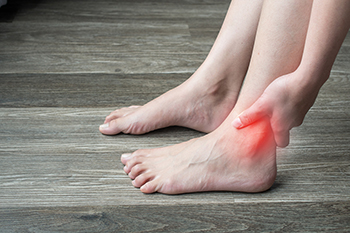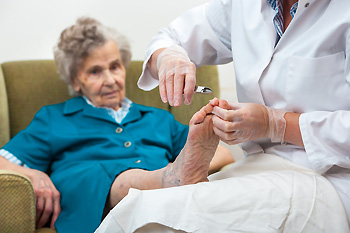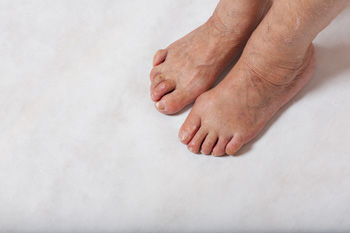Items filtered by date: April 2025
Various Causes of Foot Pain

Foot pain can affect your daily life, especially when it involves the big toe or ball of the foot. Common causes include gout, bunions, and Morton’s neuroma. Gout is a type of arthritis caused by a buildup of uric acid, often resulting in sudden, intense pain, redness, and swelling, typically in the big toe. Bunions are bony bumps that form at the base of the big toe, leading to discomfort, stiffness, and difficulty walking. Morton’s neuroma involves thickening of tissue around a nerve in the ball of the foot, causing burning pain, tingling, or numbness between the toes. These conditions can make every step feel sharp, aching, or even electric. Wearing tight shoes or standing for long periods can worsen symptoms. A podiatrist can diagnose the cause of your foot pain through a physical exam and imaging. Treatment may include custom orthotics, medication, or minor procedures to relieve pain and restore comfort. If you have ongoing foot pain, it is suggested that you schedule an appointment with a podiatrist.
Foot Pain
Foot pain can be extremely painful and debilitating. If you have a foot pain, consult with Philip Hahn, DPM from Advanced Foot & Ankle Center. Our doctor will assess your condition and provide you with quality foot and ankle treatment.
Causes
Foot pain is a very broad condition that could be caused by one or more ailments. The most common include:
- Bunions
- Hammertoes
- Plantar Fasciitis
- Bone Spurs
- Corns
- Tarsal Tunnel Syndrome
- Ingrown Toenails
- Arthritis (such as Gout, Rheumatoid, and Osteoarthritis)
- Flat Feet
- Injury (from stress fractures, broken toe, foot, ankle, Achilles tendon ruptures, and sprains)
- And more
Diagnosis
To figure out the cause of foot pain, podiatrists utilize several different methods. This can range from simple visual inspections and sensation tests to X-rays and MRI scans. Prior medical history, family medical history, and any recent physical traumatic events will all be taken into consideration for a proper diagnosis.
Treatment
Treatment depends upon the cause of the foot pain. Whether it is resting, staying off the foot, or having surgery; podiatrists have a number of treatment options available for foot pain.
If you have any questions, please feel free to contact our office located in Texarkana, TX . We offer the newest diagnostic and treatment technologies for all your foot care needs.
Caring for Diabetic Foot Infections

People with diabetes are at higher risk for foot infections due to poor circulation and reduced feeling in the feet. Small cuts, blisters, or sores can go unnoticed and quickly turn into serious infections if not treated. Signs of a diabetic foot infection include redness, swelling, warmth, pain, or drainage from a wound. Sometimes, there may be little pain even with a severe infection. A podiatrist will examine the foot carefully and may order tests such as X-rays or lab work to check for bone involvement or deeper tissue damage. Treatment depends on the severity of the infection and may include antibiotics, wound care, and sometimes surgical cleaning. Managing blood sugar levels and inspecting feet daily are key to preventing problems. Because diabetic foot infections can become dangerous quickly, it is suggested that you see a podiatrist at the first sign of a foot wound or infection.
Diabetic foot care is important in preventing foot ailments such as ulcers. If you are suffering from diabetes or have any other concerns about your feet, contact Philip Hahn, DPM from Advanced Foot & Ankle Center. Our doctor can provide the care you need to keep you pain-free and on your feet.
Diabetic Foot Care
Diabetes affects millions of people every year. The condition can damage blood vessels in many parts of the body, especially the feet. Because of this, taking care of your feet is essential if you have diabetes, and having a podiatrist help monitor your foot health is highly recommended.
The Importance of Caring for Your Feet
- Routinely inspect your feet for bruises or sores.
- Wear socks that fit your feet comfortably.
- Wear comfortable shoes that provide adequate support.
Patients with diabetes should have their doctor monitor their blood levels, as blood sugar levels play such a huge role in diabetic care. Monitoring these levels on a regular basis is highly advised.
It is always best to inform your healthcare professional of any concerns you may have regarding your feet, especially for diabetic patients. Early treatment and routine foot examinations are keys to maintaining proper health, especially because severe complications can arise if proper treatment is not applied.
If you have any questions please feel free to contact our office located in Texarkana, TX . We offer the newest diagnostic and treatment technologies for all your foot and ankle needs.
What Is Sinus Tarsi Syndrome?

Sinus tarsi syndrome is a painful condition that affects the outer part of the foot, specifically in the small cavity between the talus and calcaneus bones. Often resulting from an ankle sprain or repetitive strain, sinus tarsi syndrome leads to inflammation and instability in the area. People with flat feet or who engage in activities like running, dancing, or sports that involve quick turns or uneven surfaces, are more likely to develop sinus tarsi syndrome. Symptoms include persistent, dull pain on the outer foot, along with tenderness and a feeling of instability, which often worsens with activity or walking on uneven ground. Diagnosing this condition typically involves a physical examination and imaging tests like MRI scans. Treatment may include rest, anti-inflammatory medication, and custom orthotics for support. In more severe cases, steroid injections or even surgery may be needed for long-term relief. If you have pain on the outer part of your foot, it is suggested that you schedule an appointment with a podiatrist for a proper diagnosis and appropriate treatment.
Ankle pain can have many different causes and the pain may potentially be serious. If you have ankle pain, consult with Philip Hahn, DPM from Advanced Foot & Ankle Center. Our doctor will assess your condition and provide you with quality foot and ankle treatment.
Ankle pain is any condition that causes pain in the ankle. Due to the fact that the ankle consists of tendons, muscles, bones, and ligaments, ankle pain can come from a number of different conditions.
Causes
The most common causes of ankle pain include:
- Types of arthritis (rheumatoid, osteoarthritis, and gout)
- Ankle sprains
- Broken ankles
- Achilles tendinitis
- Achilles tendon rupture
- Stress fractures
- Tarsal tunnel syndrome
- Plantar fasciitis
Symptoms
Symptoms of ankle injury vary based upon the condition. Pain may include general pain and discomfort, swelling, aching, redness, bruising, burning or stabbing sensations, and/or loss of sensation.
Diagnosis
Due to the wide variety of potential causes of ankle pain, podiatrists will utilize a number of different methods to properly diagnose ankle pain. This can include asking for personal and family medical histories and of any recent injuries. Further diagnosis may include sensation tests, a physical examination, and potentially x-rays or other imaging tests.
Treatment
Just as the range of causes varies widely, so do treatments. Some more common treatments are rest, ice packs, keeping pressure off the foot, orthotics and braces, medication for inflammation and pain, and surgery.
If you have any questions, please feel free to contact our office located in Texarkana, TX . We offer the newest diagnostic and treatment technologies for all your foot care needs.
Why Regular Foot Exams Matter for Older Adults

As we age, changes in circulation, skin health, and nerve function can increase the risk of foot problems. Regular foot exams help detect issues early, such as skin breakdown, poor circulation, deformities, or loss of sensation. These changes can lead to serious complications if not addressed promptly. During a foot exam, a podiatrist checks for signs of corns, calluses, ulcers, nail disorders, and circulation problems. They also assess for conditions like neuropathy, arthritis, or balance issues that can affect mobility and increase the risk of falls. Routine foot care and exams are an important part of staying active and independent. Older adults with diabetes, vascular disease, or difficulty trimming their nails benefit especially from regular professional care. If you or a loved one are experiencing foot discomfort or mobility issues, it is suggested that you schedule an appointment with a podiatrist to ensure early diagnosis and proper treatment.
If you need your feet checked, contact Philip Hahn, DPM of Advanced Foot & Ankle Center. Our doctor will attend to all of your foot and ankle needs and provide you with quality treatment.
Geriatrics and Podiatry
When people age, some common issues that may occur are bone density loss, dry skin, poor circulation, and rough brittle nails. These issues may also affect your foot health if the necessary steps are not taken to alleviate the problems.
It is important to take care of your feet because feet that are injured or diseased can affect your overall health. Having painful feet hinders your ability to do daily activities or may decrease your willingness to do the things that you need to do.
Visiting Your Geriatrician
As we age, health problems become more likely, so it is essential to visit your doctor for check-ups to ensure that you are doing the best you can to take care of your health. It is recommended to check your feet frequently for any possible cuts, bruises, swelling, corns or any other irregularities.
Taking Care of Elderly Feet
Cracked or dry feet can be treated by applying moisturizer often. It is also important not to wear old socks because the older the sock is, the higher the possibility there will be that there is bacteria there. Wear fresh socks and make sure they fit properly.
Proper foot health means that you can have a more active lifestyle and you will not be bogged down by pain. Foot health also leads to good circulation, which is paramount for overall health.
If you have any questions, please feel free to contact our office located in Texarkana, TX . We offer the newest diagnostic tools and technology to treat your foot and ankle needs.
Implant Options for Rigid Hammertoe

When it comes to correcting rigid hammertoe deformities, surgery often includes the use of implants to help straighten and stabilize the toe. One important decision in this process is whether to use a permanent implant or one that can be removed later. Permanent implants are designed to stay in place indefinitely, providing long-term support and alignment. They are often chosen for their durability and the convenience of not requiring a second procedure for removal. Removable implants offer flexibility. Once the toe has healed in the proper position, these implants can be taken out, leaving the body free of foreign materials. The choice between permanent and removable implants depends on several factors, including the severity of the deformity, the patient’s lifestyle, and overall health. If you have a painful rigid hammertoe, it is suggested that you obtain a personalized consultation with a podiatrist who will help you determine the most appropriate solution for its correction
Hammertoe
Hammertoes can be a painful condition to live with. For more information, contact Philip Hahn, DPM from Advanced Foot & Ankle Center. Our doctor will answer any of your foot- and ankle-related questions.
Hammertoe is a foot deformity that affects the joints of the second, third, fourth, or fifth toes of your feet. It is a painful foot condition in which these toes curl and arch up, which can often lead to pain when wearing footwear.
Symptoms
- Pain in the affected toes
- Development of corns or calluses due to friction
- Inflammation
- Redness
- Contracture of the toes
Causes
Genetics – People who are genetically predisposed to hammertoe are often more susceptible
Arthritis – Because arthritis affects the joints in your toes, further deformities stemming from arthritis can occur
Trauma – Direct trauma to the toes could potentially lead to hammertoe
Ill-fitting shoes – Undue pressure on the front of the toes from ill-fitting shoes can potentially lead to the development of hammertoe
Treatment
Orthotics – Custom made inserts can be used to help relieve pressure placed on the toes and therefore relieve some of the pain associated with it
Medications – Oral medications such as anti-inflammatories or NSAIDs could be used to treat the pain and inflammation hammertoes causes. Injections of corticosteroids are also sometimes used
Surgery – In more severe cases where the hammertoes have become more rigid, foot surgery is a potential option
If you have any questions please contact our office located in Texarkana, TX . We offer the newest diagnostic and treatment technologies for all your foot and ankle needs.




